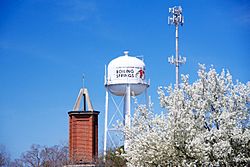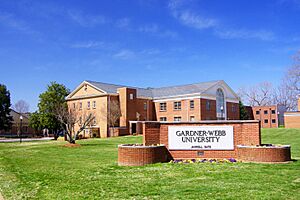Boiling Springs, North Carolina facts for kids
Quick facts for kids
Boiling Springs, North Carolina
|
|
|---|---|

Water tower in Boiling Springs
|
|
| Motto(s):
"Crossroads of Opportunity"
|
|

Location of Boiling Springs, North Carolina
|
|
| Country | United States |
| State | North Carolina |
| County | Cleveland |
| Area | |
| • Total | 4.48 sq mi (11.60 km2) |
| • Land | 4.48 sq mi (11.60 km2) |
| • Water | 0.00 sq mi (0.00 km2) |
| Elevation | 856 ft (261 m) |
| Population
(2020)
|
|
| • Total | 4,615 |
| • Density | 1,029.90/sq mi (397.69/km2) |
| Time zone | UTC-5 (Eastern (EST)) |
| • Summer (DST) | UTC-4 (EDT) |
| ZIP code |
28017
|
| Area code(s) | 704 |
| FIPS code | 37-06800 |
| GNIS feature ID | 2405296 |
Boiling Springs is a town in Cleveland County, North Carolina, United States. It is located in the western part of the Charlotte metropolitan area. The town is about 50 miles away from the city of Charlotte. In 2010, the town had a population of 4,647 people. Boiling Springs is also home to Gardner–Webb University. The town gets its name from a natural spring found on the university's land. This spring feeds a small lake.
Contents
History of Boiling Springs
Early Settlement and Naming
People started settling in the area around the natural "boiling springs" in 1843. The first families to live here were the Hamricks, Greenes, and McSwains. Because of the springs, the settlement was named Boiling Springs. One of the first buildings was the Boiling Springs Baptist Church, built in 1847. It was about 100 yards from the springs.
Growth of the Town and School
For a long time, Boiling Springs was a quiet community. It did not have railroads, many businesses, or paved streets. Around the year 1900, two church groups, Kings Mountain Baptist and Sandy Run Associations, looked for a place to build a high school. They chose Boiling Springs because it was located between their two areas. The community also worked hard to attract the school.
The Boiling Springs High School boarding institution opened in 1905. School leaders wanted to make sure certain items were not sold near the school. So, in 1911, the town officially became a town. This allowed them to ban the sale of those items. The town's boundaries were set by drawing a mile and a half circle from the school's original bell tower.
Becoming an official town was a big step forward. It created a local government that could help the town grow. This government could provide important services like water, police, fire protection, paved streets, and garbage collection. The town's growth was closely linked to the school's growth. The high school later became Boiling Springs Junior College in 1928. Then it became Gardner-Webb Junior College in 1942. Finally, it became Gardner–Webb University in 1993, offering many college and graduate programs.
Historic Buildings in Boiling Springs
Two important historical buildings in Boiling Springs are listed on the National Register of Historic Places. These are E. B. Hamrick Hall and the Irvin-Hamrick Log House.
Geography of Boiling Springs
Boiling Springs is located in the southwestern part of Cleveland County. North Carolina Highway 150 goes through the town. This highway leads east about 9 miles to Shelby, which is the county seat. It also leads south about 13 miles to Gaffney, South Carolina. The border of South Carolina is less than 6 miles south of the town. Mooresboro is 4 miles north. Charlotte, a larger city, is about 50 miles to the east.
The town covers an area of about 11.5 square kilometers (4.48 square miles). All of this area is land. The Broad River flows about 3 miles south of the town. This area is home to the Broad River Greenway, which has places for outdoor activities and trails.
Population and People
| Historical population | |||
|---|---|---|---|
| Census | Pop. | %± | |
| 1930 | 672 | — | |
| 1940 | 613 | −8.8% | |
| 1950 | 1,145 | 86.8% | |
| 1960 | 1,311 | 14.5% | |
| 1970 | 2,284 | 74.2% | |
| 1980 | 2,381 | 4.2% | |
| 1990 | 2,445 | 2.7% | |
| 2000 | 3,866 | 58.1% | |
| 2010 | 4,647 | 20.2% | |
| 2020 | 4,615 | −0.7% | |
| 2023 (est.) | 4,637 | −0.2% | |
| U.S. Decennial Census | |||
Who Lives in Boiling Springs?
The United States Census helps us understand the population of towns. As of the 2020 census, there were 4,615 people living in Boiling Springs. These people lived in 1,144 households, and 877 of these were families.
| Race | Number | Percentage |
|---|---|---|
| White (non-Hispanic) | 3,625 | 78.55% |
| Black or African American (non-Hispanic) | 594 | 12.87% |
| Native American | 6 | 0.13% |
| Asian | 41 | 0.89% |
| Other/Mixed | 176 | 3.81% |
| Hispanic or Latino | 173 | 3.75% |
Schools in Boiling Springs
Boiling Springs has several schools, from elementary to university level.
- Gardner-Webb University (a private university)
- Willow Tree Community School (a private school)
- Crest Middle School (part of Cleveland County Public Schools)
- Crest High School (part of Cleveland County Public Schools)
- Boiling Springs Elementary (part of Cleveland County Public Schools)
- Springmore Elementary (part of Cleveland County Public Schools)
Getting Around Boiling Springs
Air Travel
For flying, there are a few airports nearby:
- Charlotte Douglas International Airport is about 46 miles east of Boiling Springs.
- Greenville–Spartanburg International Airport is about 47 miles south.
- Shelby Cleveland County Regional Airport is a smaller airport, 4 miles east of town.
Roads
- NC Route 150 goes right through the town.
- US Route 74 passes about 3 miles north of Boiling Springs.
- Interstate 85 is 13 miles south and 25 miles east of the town.
Walking and Biking
- There is a bike lane along NC 150 (South Main) that connects to the Broad River Greenway.
- However, there are not many other places specifically for walking or biking.
Notable People from Boiling Springs
Many interesting people have connections to Boiling Springs:
- W. J. Cash, an author
- Blake Lalli, a former MLB (Major League Baseball) player
- Gerald R. Murray, who was the 14th Chief Master Sergeant of the Air Force
- Ron Rash, a poet, short story writer, and novelist
- David Thompson, a former NBA (National Basketball Association) player
- Storm Duck, an NFL (National Football League) player
See also
 In Spanish: Boiling Springs (Carolina del Norte) para niños
In Spanish: Boiling Springs (Carolina del Norte) para niños


